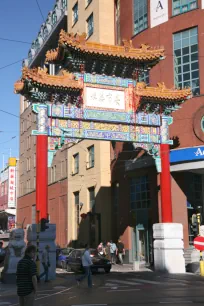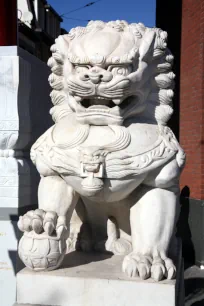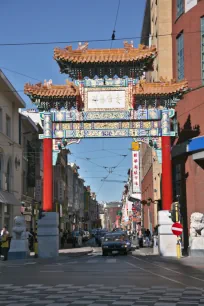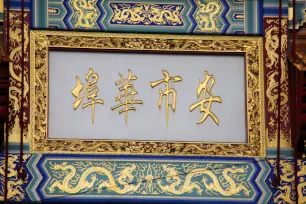A Chinese Gate, known as the Pagodepoort (Pagoda Gate), marks the entrance to Antwerp’s small Chinatown. The colorfully decorated gate was built in 2010 after four years of planning.



Chinatown
Chinatowns are a relatively new phenomenon in continental Europe. Most of the famous Chinatowns are in the US, a result of a large influx of Chinese workers in the nineteenth and early twentieth century. The American policy of racial exclusion stimulated the concentration of ethnic groups. In Europe, however, Chinatowns were created spontaneously and on a much smaller scale.
Antwerp’s ‘Chinatown’ started to develop in the 1970s when several Chinese restaurants opened in the Van Wesenbekestraat, a street in the neighborhood of the Central Station. They targeted a Chinese clientele that frequented the local market hall. Over time, more and more Chinese shops opened, and the area also became the center of Chinese cultural life. Chinese New Year and other events are celebrated in this street with fireworks and dragon dances.
Lion statues
In 2001 the street and surrounding area was officially recognized as Chinatown. The city and the Chinese community started negotiations to improve the – rather run-down and drab looking – street. The idea of a Chinese gate was launched but initially rejected due to difficulties with the overhead electrical wires for the streetcars. Instead, four large marble lion statues were installed to mark the entrances to ‘Chinatown’ and protect its inhabitants. The street was also decorated with dragon shaped streetlights.
Construction
In 2005 the idea to build a Chinese gate was picked up again and in 2006 the city council decided to go ahead with the project. Construction was scheduled for 2007, but protests by a local shop owner – who feared the obstruction of his store – caused a three-year delay.
Finally, in mid 2010 construction of the gate started. The structure was created in China and shipped in parts to Antwerp, where it was reassembled. Chinese workers then placed the ornaments on the gate, after which it was painted and decorated with gold foil.
The gate was officially completed on September 29, 2010. The inauguration could be seen live from the World Expo in Shanghai, China.
Design

The gate – locally known as the Pagodepoort – was created by the Tianjin Metallurgical Planning & Designing Institute in China in collaboration with architect Yang Wenlin. They created a tall gate – high enough to tower over the electrical wires of the streetcar – with steel pillars. On top of the ceramic roof are small statues of mythical creatures. Woodwork is colorfully painted and decorated with gilded relief sculptures.
The names of sponsors, who funded half the cost of the gate – an estimated 220,000 euro – are inscribed at the base of the monument.
- Next: Vlaamse Opera
- More Sights & Attractions in Antwerp

